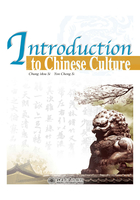
Foreword
It is not uncommon today for visitors to China to be awestruck by the hyper-modern shape of the nation's major cities. The steel and glass skyscrapers reflect both the buzz of life on the streets below and the cranes on the skyline constructing the next architectural wonder alongside. The impact of the country's double digit growth rates is evident everywhere in China's major urban centres.
Confronted with such dramatic twenty-first century hypermodernity it is easy to forget the narratives that formed China's lengthy history and underpin her current success. While iconic structures such as The Great Wall and the Forbidden City stand as reminders of the power of dynasties past, the cultural logic that made such wonders of cultural heritage meaningful is not so evident. China's awe-inspiring past is connected directly to its equally awe-inspiring present by a common set of core stories that everyone raised in China cannot help but know.Introduction to Chinese Culture provides readers with precisely these core narratives that have sustained Chinese culture for centuries.
Despite all the shifts in economic, military, political and developmental spheres, there is a popularly embraced common knowledge about Chinese culture that the Chinese people feel is fundamentally theirs at the core. Professor CM Si and his team have gathered the most important of these together to create an enlightening and accessible volume. It introduces readers to the key aspects of Chinese culture and brings the stories behind the key locations and personages together.
They have compiled this illustrated volume of 56 succinct essays grouped within 8 chapters, to cover the core myths, festivals, historical sights, food and sports, arts and crafts, language and literature, philosophy and international connections. These iconic stories, localities and cultural practices stretch back thousands of years and have emerged from amidst myriad other possible competitors as the foundational cultural grammar of twenty-first century China. Professor Si has drawn on his extensive experience in teaching and deep knowledge of Chinese culture to select the core components from amidst China's vast cultural heritage.
These essays not only tell readers about ‘traditions' but they also tell us how these traditions have changed over time and transformed into contemporary practices and beliefs. We learn about how festivals evolve over time to cope with new social forces while still maintaining their integrity as time-honored ‘traditions'. Professor Si explains how early Chinese scientific concepts that explained the nature of the world interacted with other types of science from around the world. We learn about the way that longstanding Chinese concepts of ‘the calculation of time' in the annual cycle altered in relation to contact with Europe — but also how the Chinese calendar remains as a core marker for foundational cultural events such as Spring Festival, Yuanxiao and Qingming.
Taken as a whole, the chapters create a lively picture of how complex interpersonal relations experienced by ordinary people throughout the centuries — such as love and romance; birth and death; friendship and loyalty — have been negotiated through storytelling. We also learn about the complex connection between individuals and their leaders through the chapters on the imperial dynasties through to the contemporary government with its 56 national minorities.
In sum, this book will be invaluable to all students of Chinese culture but also to the educated observer of world cultures and travelers to China. In understanding the foundational principles underlying Chinese culture, readers will be able to make far better sense of the uniqueness of the twenty-first century China that they see before them. Moreover, readers will recognize the features that Professor Si has narrated in the dynamics of the myriad Chinese communities in Asia, Africa, the Americas and Europe.
Congratulations to Professor Si and to Peking University Press for their foresight in producing such an accessible and lively introduction to the core of Chinese culture. China's importance to the world is more evident today than it has been for decades and this book will go a long way to ensuring enhanced knowledge of the culture that underpins the twenty-first century superpower.
Professor Louise Edwards (FAHA, FASSA)
The University of Hong Kong
Modern China Program